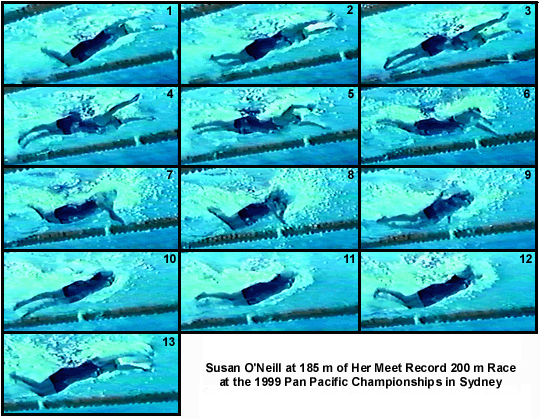HOW CHAMPIONS DO IT
Researched, produced, and prepared by Brent S. Rushall,
Ph.D., R.Psy.

SUSAN O'NEILL AT 185 m OF HER MEET RECORD 200 m RACE AT THE 1999 PAN PACIFIC CHAMPIONSHIPS IN SYDNEY
Each frame is .1 seconds apart. This sequence is from Susan O'Neill's semi-final 200-m race in which she set a new meet record of 2:06.53. It should be compared to other breathing-stroke sequences of this swimmer in this section of the Swimming Science Journal. In this presentation, only general comments will be made relative to those other analyses.
Notable Features
As in all other swims, Susan O'Neill's hand movement immediately after entry is still troublesome. The outward scull of the hands produces only a very small force that most probably would not contribute to acceleration but could maintain the swimmer's velocity. In this sequence, .4 seconds elapses before the development of direct propulsion is initiated. It could be argued however, that the duration of this outward scull is marginally less than three years previously in the Atlanta Olympic Games. If that is so, then it is a very minor improvement but still in need of virtual eradication.
- If Susan O'Neill's hands entered the water and remained flat, rather than pronating outward, the downward force of that type of entry could reduce the diving of the shoulders. It would also allow her to create propulsion earlier. This single feature would substantially affect propulsion as well as reduce drag resistance by having her swim "flatter." That would result in greater stroke velocity.
- In this swim, Susan O'Neill's time is 1.23 seconds faster than she recorded at Atlanta 37 months earlier. It would be nice to think that this improvement is due to increases in technique accuracy. However, a more likely explanation is the way she is now pacing her races. At Atlanta, she split 1:00.66 with a second split of 1:07.1. In this race in Sydney, she split 1:01.78 with a second split of 1:04.75. Susan O'Neill's improved times are more likely to have resulted from better pacing of her races. On several occasions, this has been obvious. In some of her duels with Misty Hyman, a swimmer who chronically overreaches in the first half of a 200-m race, Susan O'Neill has often trailed by as much as a body length at the 100-m split, only to then "cruise" past a failing Misty Hyman. Similar race patterns have also emerged when Susan O'Neill has dueled against her Australian teammate and perennial runner-up, Petria Thomas. The exceptional anaerobic nature of butterfly warrants very exact even pacing to accomplish a top performance. Susan O'Neill appears to have learned that lesson. It could be argued this physiological explanation is the reason for her improvement over the past three years.

Return to Table of Contents for this section.




